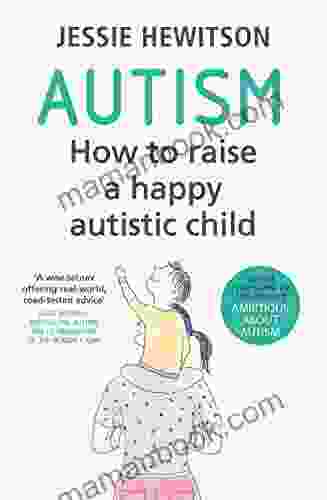Empowering Parents: A Comprehensive Guide to Raising a Happy Autistic Child

Autism spectrum disorder (ASD) is a complex neurodevelopmental condition that affects a child's communication, social skills, and behavior. While raising an autistic child can present unique challenges, it is crucial to remember that every child is unique and has their own strengths and needs. With the right support, understanding, and strategies, parents can help their autistic children thrive and live happy, fulfilling lives.
1. Understanding Autism: A Spectrum of Differences
ASD is a spectrum disorder, meaning that individuals can exhibit a wide range of symptoms and behaviors. While there is no single "typical" autistic child, some common characteristics include:
4.7 out of 5
| Language | : | English |
| File size | : | 2543 KB |
| Text-to-Speech | : | Enabled |
| Screen Reader | : | Supported |
| Enhanced typesetting | : | Enabled |
| Word Wise | : | Enabled |
| Print length | : | 402 pages |
- Social Differences: Difficulty understanding social cues, interacting with others, and forming relationships.
- Communication Challenges: May struggle with verbal and nonverbal communication, speech delays, or echolalia.
- Sensory Sensitivities: May be over- or under-responsive to sights, sounds, smells, tastes, or textures.
- Restricted and Repetitive Behaviors: May engage in repetitive movements, routines, or interests.
- Cognitive Variations: May exhibit strengths or challenges in areas such as memory, problem-solving, or imagination.
It's important to note that not all autistic individuals experience the same symptoms or to the same degree. Every child is an individual with their own unique strengths, needs, and challenges.
2. Early Intervention: A Key to Success
Early intervention is crucial for supporting the development of autistic children. Early detection and intervention can improve outcomes in areas such as communication, social skills, and behavior. If you suspect your child may be autistic, seek professional evaluation promptly.
- Early intervention services may include:
- Speech and language therapy
- Occupational therapy
- Physical therapy
- Behavioral therapy
3. Positive Parenting: Empowering Children
Positive parenting is essential for promoting the well-being of autistic children. Here are some key principles:
- Acceptance and Respect: Treat your child with dignity and respect, valuing their unique strengths and needs.
- Consistency and Structure: Provide clear and consistent routines and expectations to create a predictable environment.
- Visual Supports: Use visual cues, such as schedules, pictures, or charts, to help your child understand and follow expectations.
- Positive Reinforcement: Reward and praise your child for desired behaviors to reinforce positive actions.
- Empathy and Understanding: Try to see the world from your child's perspective and understand their challenges.
4. Educational Support: Advocating for Your Child
Education is a fundamental right for all children, including autistic children. Parents should actively advocate for their child's educational needs:
- Individualized Education Program (IEP): Ensure your child has an IEP that outlines their unique needs and services.
- Educational Placement: Advocate for your child's placement in the most appropriate educational setting, whether it's a general education classroom, special education classroom, or therapeutic setting.
- Collaboration and Communication: Establish open communication and collaboration with your child's teachers, therapists, and other professionals involved in their education.
5. Social Development: Fostering Connections
Social development is crucial for autistic children's well-being. Parents can help foster social connections by:
- Social Skills Groups: Enroll your child in social skills groups or activities where they can practice interacting with peers.
- Peer Support: Encourage peer interactions by connecting with other autistic children and their families.
- Interest-Based Activities: Find activities that your child enjoys and can participate in with others.
- Community Involvement: Engage in community events and activities to expose your child to different social situations.
6. Sensory Management: Creating a Calming Environment
Many autistic children experience sensory sensitivities. Parents can help create a calming environment by:
- Sensory Room: Consider creating a sensory room in your home where your child can escape overstimulation.
- Sensory Toys: Provide your child with sensory toys that meet their specific needs, such as fidget toys, weighted blankets, or noise-canceling headphones.
- Quiet Spaces: Designate quiet spaces in your home where your child can retreat to when they feel overwhelmed.
- Sensory Diet: Consult with an occupational therapist to develop a sensory diet that provides your child with the sensory input they need.
7. Medical and Therapeutic Support: Addressing Specific Needs
While there is no cure for autism, various medical and therapeutic interventions can help address specific needs and improve outcomes. These may include:
- Medication: Medications can help manage certain symptoms of autism, such as anxiety, impulsivity, or hyperactivity.
- Behavioral Therapy: Applied behavior analysis (ABA) and other behavioral therapies can teach specific skills and reduce challenging behaviors.
- Occupational Therapy: Occupational therapists help children develop fine and gross motor skills, sensory processing, and daily living skills.
- Speech and Language Therapy: Speech therapists help children develop communication skills, including speech, language, and social communication.
8. Community Resources and Support
Raising an autistic child can be demanding, but there are many resources and support systems available to assist parents.
- Autism Support Organizations: National organizations such as Autism Speaks, Autism Society, and the Autism Self Advocacy Network provide resources, advocacy, and support.
- Local Support Groups: Connect with other parents of autistic children in your community for support and information sharing.
- Government Programs: Explore government programs and services that may provide financial assistance, support services, or educational benefits.
- Respite Care: Respite care provides temporary care for your child, giving you a break to rest or attend to other responsibilities.
- Set Boundaries: Establish clear boundaries to protect your time and energy.
- Practice Self-Care: Engage in activities that bring you joy and relaxation, such as hobbies, exercise, or spending time with loved ones.
- Seek Support: Connect with other parents, friends, family members, or support groups for emotional support and practical assistance.
- Utilize Respite Care: Take advantage of respite care services to give yourself a break and recharge.
9. Self-Care for Parents: Nurturing Your Own Well-being
Parenting an autistic child requires significant time, energy, and emotional investment. It's crucial for parents to prioritize their own self-care to maintain their well-being:
: Embracing the Journey
Raising an autistic child can be both challenging and rewarding. By understanding autism, embracing positive parenting, advocating for your child's needs, fostering social development, managing sensory sensitivities, accessing medical and therapeutic support, connecting with community resources, and prioritizing self-care, parents can create a supportive and nurturing environment where their autistic children can thrive and live happy, fulfilling lives. Remember that every child is unique, and the journey will be different for each family. With love, acceptance, and a commitment to their child's well-being, parents can empower autistic children to reach their full potential and experience the joy of a happy and fulfilling life.
4.7 out of 5
| Language | : | English |
| File size | : | 2543 KB |
| Text-to-Speech | : | Enabled |
| Screen Reader | : | Supported |
| Enhanced typesetting | : | Enabled |
| Word Wise | : | Enabled |
| Print length | : | 402 pages |
Do you want to contribute by writing guest posts on this blog?
Please contact us and send us a resume of previous articles that you have written.
 Top Book
Top Book Novel
Novel Fiction
Fiction Nonfiction
Nonfiction Literature
Literature Paperback
Paperback Hardcover
Hardcover E-book
E-book Audiobook
Audiobook Bestseller
Bestseller Classic
Classic Mystery
Mystery Thriller
Thriller Romance
Romance Fantasy
Fantasy Science Fiction
Science Fiction Biography
Biography Memoir
Memoir Autobiography
Autobiography Poetry
Poetry Drama
Drama Historical Fiction
Historical Fiction Self-help
Self-help Young Adult
Young Adult Childrens Books
Childrens Books Graphic Novel
Graphic Novel Anthology
Anthology Series
Series Encyclopedia
Encyclopedia Reference
Reference Guidebook
Guidebook Textbook
Textbook Workbook
Workbook Journal
Journal Diary
Diary Manuscript
Manuscript Folio
Folio Pulp Fiction
Pulp Fiction Short Stories
Short Stories Fairy Tales
Fairy Tales Fables
Fables Mythology
Mythology Philosophy
Philosophy Religion
Religion Spirituality
Spirituality Essays
Essays Critique
Critique Commentary
Commentary Glossary
Glossary Bibliography
Bibliography Index
Index Table of Contents
Table of Contents Preface
Preface Introduction
Introduction Foreword
Foreword Afterword
Afterword Appendices
Appendices Annotations
Annotations Footnotes
Footnotes Epilogue
Epilogue Prologue
Prologue Katherine Stewart
Katherine Stewart John Locke
John Locke Roberta Kagan
Roberta Kagan Mika Lane
Mika Lane Heidi Kessler
Heidi Kessler Patrick D Hahn
Patrick D Hahn James D Shipman
James D Shipman Erin Gleeson
Erin Gleeson Joellen Patterson
Joellen Patterson Douglas Murray
Douglas Murray Jennifer Lemberg
Jennifer Lemberg Ira Shor
Ira Shor Benjamin T Smith
Benjamin T Smith Helen Baumann
Helen Baumann Roxanne Riley
Roxanne Riley The Brothers Rodemeyer
The Brothers Rodemeyer Judith Carter
Judith Carter P G Van
P G Van Deborah Parker
Deborah Parker Penny Simkin
Penny Simkin
Light bulbAdvertise smarter! Our strategic ad space ensures maximum exposure. Reserve your spot today!

 Frank ButlerThe Twins of Mystic Falls: A Supernatural Saga of Love, Loss, and the Power...
Frank ButlerThe Twins of Mystic Falls: A Supernatural Saga of Love, Loss, and the Power...
 Leslie CarterPPI Structural Depth Practice Exams for the PE Civil Exam 4th Edition eText...
Leslie CarterPPI Structural Depth Practice Exams for the PE Civil Exam 4th Edition eText... Edmund HayesFollow ·11.4k
Edmund HayesFollow ·11.4k Colin RichardsonFollow ·4.8k
Colin RichardsonFollow ·4.8k Branson CarterFollow ·2.4k
Branson CarterFollow ·2.4k Denzel HayesFollow ·4k
Denzel HayesFollow ·4k Leslie CarterFollow ·2.8k
Leslie CarterFollow ·2.8k Fernando PessoaFollow ·8.6k
Fernando PessoaFollow ·8.6k J.D. SalingerFollow ·18.5k
J.D. SalingerFollow ·18.5k Ethan GrayFollow ·11.2k
Ethan GrayFollow ·11.2k

 Ernest Powell
Ernest PowellBenefits of Corporal Punishment: A Review of the...
Corporal punishment is a form of physical...

 Bobby Howard
Bobby HowardThe Development and Significance of African American...
African American...

 Guy Powell
Guy PowellDown Girl: The Logic of Misogyny - A Comprehensive...
In her groundbreaking work,...

 Forrest Blair
Forrest BlairThe Bikini Changing Room: A Micro Mini Romance
In the heart of...
4.7 out of 5
| Language | : | English |
| File size | : | 2543 KB |
| Text-to-Speech | : | Enabled |
| Screen Reader | : | Supported |
| Enhanced typesetting | : | Enabled |
| Word Wise | : | Enabled |
| Print length | : | 402 pages |












